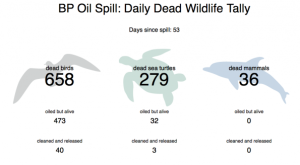The deepwater Horizon spill or the BP oil spill was an oil spill in Gulf of Mexico and flowed for three months in the year 2010. The oil spill is continues to seep through the water bed. It is the largest spill in the history of petroleum industry. About 5 million barrels of crude oil flowed in the Gulf of Mexico region. The oil was too dispersed to be recovered and by 2012 persistent oil seep has been reported. The scientists are still measuring the effects of the million gallons oil that is flooding the gulf after this massive explosion of 2010.
The BP oil spill caused extensive damage to coastal ecosystem.
The basic damage that these oil spills cause are those caused to the marine fish like whales that eat the oil or it enters through their blowhole. The fish get poisoned and die. Also small organisms like plankton, larval fish, seaweed, oysters are affected because of deepwater oils spills. The fish cannot eat the plankton, so in turn they die. This disrupts the entire marine ecosystem and also endangers that species of fish. More than 8000 birds, sea turtles and marine animals have been found dead or injured in the six month span from the time of the oil spill.
The oil spills have been affecting the fish and aquatic invertebrates (including the oysters and shrimps). The oil affects through surface exposure, ingestion, absorption in the short term. In the long term their entire ecosystem is disturbed.
The oil that reached the gulf coast has been absorbed by the wetlands like sponge and some has moved along the coastline to sediment bottom affecting the shoreline that is home foe sea lives and a stopover for migratory birds. The oil spill is affecting the fish and wildlife across the gulf coast. 5 major immediate effects noted are:
1. Birds covered in oil which caused them to lose buoyancy and ability to normalize body temperature.
2. Mammals that have ingested oil may have ulcers and internal bleeding.
3. Dead and dying sea corals were discovered a few miles away from the BP oil rig.
4. Many species were breeding during the oil spill and many larvae and eggs are lost. This might be the loss of an entire generation or the entire species.
5. Some species of fishes and mammals may grow up to be deformed or with some inabilities.
There are other long term effects that have been noticed by scientists even after the oil is no longer visible on the surface. The oil has been washed away to the wetlands and the gulf coast. The full impact of this disaster will be visible in the few years to come. A successful restoration will be very challenging.
- Unbalanced food web: As the fiasco happened during the spawning season of many species of fish and mammals and many wildlife species. The toxicity of the oil hit the eggs and larval instantly. It may have deleted the entire species or maybe one generation. Because of this wipe out, the food web is affected and its effects will become evident in the years to come.
- Decline in recreation: The gulf coast heavily relied on commercialfishing and outdoor recreation to maintain their economies. According to reports fisheries accounted for $659 million in shell fish and finfish. Many million people took recreational fishing trips in the gulf that year. With the oil spill the fishing recreation was shut down for some time and there were heavy revenue losses.
- Reduced fish and wildlife: There have been fluctuations in the wildlife populations near the gulf coast.

USFWS manages the national wildlife refuge system and is helping in conservation of wildlife affected by the spill.
There is a list by the National Wildlife Federation of refuges facing the biggest threats because of the BP oil spill.
- Grand Bay National Wildlife Refuge: The Wet Pine Savanna are disappearing and under attack.
- Delta National Wildlife Refuge: Fisheries which are trying to recover from earlier spills and migratory bird sanctuary.
- Bon Secour National Wildlife Refuge: It has become a oil washing shore, which was meant to be a place of safety for the wildlife.
- Mississippi Sandhill Crane National Wildlife Refuge: It is a delicate habitat shielding the cranes and is being monitored closely.
- Breton National Wildlife Refuge: It as one of the first refuges to be affected by the BP oil spill.
These areas in the gulf coast region protect the shorelines and provide a haven to many of the threatened and endangered wildlife.
The damage due to the BP oil spill has been immense and some is unaccounted for. There are major changes to the gulf coast wildlife and restoration process continues. But the depth of the impact would take many years to overcome.




